Physio Information
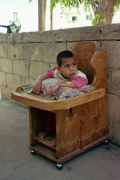 Knee
Blocks Knee
Blocks
These are useful to keep the child’s pelvis back in the
chair. Many children with spasticity, when they are placed in sitting
in a chair, lift their head to see what is going on and this causes their
hips also to extend and they push their bottoms forward in the chair.
It is tempting to put a pommel between their legs to stop them from doing
this but a pommel cannot fix them fully without being very uncomfortable.
Besides it gives the child something to push against and reinforces the
total extension. Knee blocks prevent any movement at all without being
uncomfortable. They give the child a good base from which to balance and
move trunk and head. What is more they do not allow the pelvis to be asymmetric.
This is very important for preventing subluxation of the hip joint in
the leg that might be more adducted and inwardly rotated because of retraction
of the pelvis on that side.
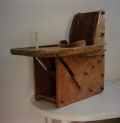 Prone
Angle (Forward Tilting) Chair Prone
Angle (Forward Tilting) Chair
This chair has a sloping seat that tilts the child forwards.
Curved blocks hold him comfortably just below his knee joints and keep
his pelvis from pulling back on either side. The high table lifts his
body up just high enough so that he can control his head but not so much
that he falls back. This kind of chair may help a child who pushes back,
using spasticity, when he is supported in sitting. It gives him the experience
of being in a sitting position without being held too tightly. Every time
he lifts his head to watch what is going on around him he will actively
extend his spine. This active extension is quite different from using
spasticity and will help to give him better control of his trunk in time.
Children who push back with spasticity also raise their arms up and back.
This can prevent them from learning to use their hands for reaching and
grasping. In the prone angle chair, because they are not using spasticity,
their arms come down and they can see their hands and begin to manipulate
toys.
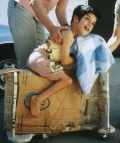 Ride
On Seat Ride
On Seat
Athetoid children with dystonic spasms are extremely difficult
to put in any position except on their backs on the floor. Mothers mostly
carry them until they become too big and heavy and then there is no choice
except on the floor. The trouble is being on the floor makes them push
more and more back into extension and then they become even harder to
handle. This kind of ride on seat supports the child in a forward sitting
position and prevents him from pushing back. He also has the possibility
of putting his feet flat on the floor and maybe moving along bit by bit.
The benefit to the child and his family is huge if he can be left even
for a short time on his own in a sitting position. He can learn to hold
his head upright and see the world around him. Friends and family will
be able to relate to him in a better way. He may in time learn to move
himself around and have a little independence and all the time his body
is learning what it feels like to be in a more useful position.
 Prone
Angle (Forward Tilting) Standing Frame Prone
Angle (Forward Tilting) Standing Frame
It is necessary for all young children to be in standing
whether or not they can balance or even take weight by themselves on their
legs. Being in standing makes their bones strong, helps good development
of their hip joints and gives them the experience of being upright which
all children enjoy. 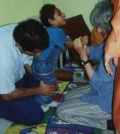 The
reason for placing a child in a prone angle standing frame rather than
an upright or backward tilting one is that it encourages active extension
of the child’s head, trunk, hips and knees. The
reason for placing a child in a prone angle standing frame rather than
an upright or backward tilting one is that it encourages active extension
of the child’s head, trunk, hips and knees. 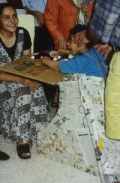 Every
time the child lifts his head to see what is going on around him his whole
body will also extend. As long as his feet are flat on the foot board
and his body is in alignment with his hips held forward, this extension
is normal and will reduce his spasticity. In an upright or backward tilting
standing frame the child is more likely to be encouraged to flex forwards. Every
time the child lifts his head to see what is going on around him his whole
body will also extend. As long as his feet are flat on the foot board
and his body is in alignment with his hips held forward, this extension
is normal and will reduce his spasticity. In an upright or backward tilting
standing frame the child is more likely to be encouraged to flex forwards.
Frames made by staff at
Sour Community Disability Programme
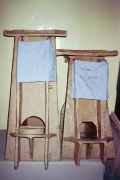
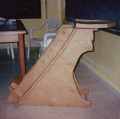
|

